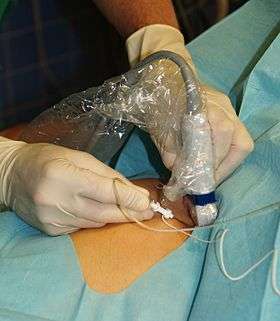Nerve block
| Nerve block | |
|---|---|
 Ultrasound guided femoral nerve block | |
| ICD-9-CM | 04.81 |
| MeSH | D009407 |
Nerve block or regional nerve blockade is any deliberate interruption of signals traveling along a nerve, often for the purpose of pain relief. Local anesthetic nerve block (sometimes referred to as simply "nerve block") is a short-term block, usually lasting hours or days, involving the injection of an anesthetic, a corticosteroid, and other agents onto or near a nerve. Neurolytic block, the deliberate temporary degeneration of nerve fibers through the application of chemicals, heat, or freezing, produces a block that may persist for weeks, months, or indefinitely. Neurectomy, the cutting through or removal of a nerve or a section of a nerve, usually produces a permanent block. Because neurectomy of a sensory nerve is often followed, months later, by the emergence of new, more intense pain, sensory nerve neurectomy is rarely performed.
The concept of nerve block sometimes include central nerve block, which includes epidural and spinal anaesthesia.[1]
Local anesthetic nerve block
A combination of local anesthetic (such as lidocaine), epinephrine, a steroid (corticosteroid), and an opioid is often used. Epinephrine produces constriction of the blood vessels which delays the diffusion of the anesthetic. Steroids can help to reduce inflammation. Opioids are painkillers. These blocks can be either single treatments, multiple injections over a period of time, or continuous infusions. A continuous peripheral nerve block can be introduced into a limb undergoing surgery – for example, a femoral nerve block to prevent pain in knee replacement.[2]
Local anesthetic nerve blocks are sterile procedures that are usually performed in an outpatient facility or hospital. The procedure can be performed with the help of ultrasound, fluoroscopy (a live X-ray), or CT to guide the physician in the placement of the needle. A probe positioning system can be used to hold the ultrasound transducer steady. Electrical stimulation can provide feedback on the proximity of the needle to the target nerve.
It is unclear if the use of epinephrine in addition to lidocaine is safe for nerve blocks of fingers and toes due to insufficient evidence.[3] Another 2015 review states that it is safe in those who are otherwise healthy.[4]
Neurolytic block
A neurolytic block is a form of nerve block involving the deliberate injury of a nerve by the application of chemicals (in which case the procedure is called "neurolysis") or physical agents such as freezing or heating ("neurotomy").[5] These interventions cause degeneration of the nerve's fibers and temporary interference with the transmission of pain signals. In these procedures, the thin protective layer around the nerve fiber (the basal lamina) is preserved so that as a damaged fiber regrows, it travels within its basal lamina tube and connects with the correct loose end; thus function may be restored.[6]
Neurectomy
Neurectomy is a surgical procedure in which a nerve or section of a nerve is severed or removed. Cutting a sensory nerve severs its basal lamina tubes, and without them to channel the regrowing fibers to their lost connections, over time a painful neuroma or deafferentation pain may develop. This is why the neurolytic is usually preferred over the surgical sensory nerve block.[6] This surgery is performed in rare cases of severe chronic pain where no other treatments have been successful, and for other conditions such as involuntary twitching and excessive blushing or sweating.[7]
A brief "rehearsal" local anesthetic nerve block is usually performed before the actual neurectomy to determine efficacy and detect side effects. The patient is typically under general anesthetic during the neurectomy, which is performed by a neurosurgeon.[7]
See also
References
- ↑ Portable Pathophysiology. Lippincott Williams & Wilkins. 2006. p. 149. ISBN 9781582554556.
- ↑ UCSD. Regional anesthesia
- ↑ Prabhakar, H; Rath, S; Kalaivani, M; Bhanderi, N (19 March 2015). "Adrenaline with lidocaine for digital nerve blocks.". The Cochrane database of systematic reviews. 3: CD010645. PMID 25790261. doi:10.1002/14651858.CD010645.pub2.
- ↑ Ilicki, J (4 August 2015). "Safety of Epinephrine in Digital Nerve Blocks: A Literature Review.". The Journal of emergency medicine. 49: 799–809. PMID 26254284. doi:10.1016/j.jemermed.2015.05.038.
- ↑ Scott Fishman; Jane Ballantyne; James P. Rathmell (January 2010). Bonica's Management of Pain. Lippincott Williams & Wilkins. p. 1458. ISBN 978-0-7817-6827-6. Retrieved 15 August 2013.
- 1 2 Williams JE. Nerve blocks: Chemical and physical neurolytic agents. In: Sykes N, Bennett MI & Yuan C-S. Clinical pain management: Cancer pain. 2nd ed. London: Hodder Arnold; 2008. ISBN 978-0-340-94007-5. p. 225–35.
- 1 2 McMahon, M. (2012, November 6). What is a Neurectomy? (O. Wallace, Ed.) Retrieved from wise GEEK: http://www.wisegeek.com/what-is-a-neurectomy.htm#